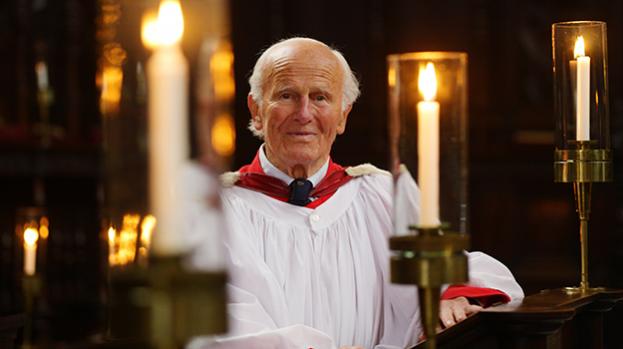Church musicians owe an enormous debt to Sir David Willcocks, who died aged 95, on 17th September 2015.
As a précis of his eventful life and remarkable achievements, I cannot add much more to his fascinating Telegraph obituary (http://www.telegraph.co.uk/news/obituaries/11872141/Sir-David-Willcocks-choirmaster-obituary.html), but will submit a few personal views on his work.
The skill of a good arranger or descant-writer – or anyone with the temerity to mess about with an already established and well-loved work – is twofold. First, is it dangerous to attempt to alter the nature or scope of the existing piece. A hymn or carol, in its natural and perfect form, has the music and lyrics in perfect balance: a state sometimes only reached after centuries of development, with all associated missteps and improvements. Continued use by many generations is a great leveller: the less successful ideas are forgotten to history; the best ideas endure. For a present-day writer to unilaterally add an overblown or undercooked last verse, entirely at odds with all that precedes it, is at best, ignorant; at worst, arrogant.
The second part of the arranger’s skill is to improve the quality or reception of the existing piece. To add something that does not benefit the piece – adding nothing of value, in effect – won’t cut it. What, then, would be the point?
In his work, David Willcocks not only deftly sidestepped these two critical pitfalls himself; he produced masterclasses to those who attempt the same. And if I had to summarise his whole ethos, it was that he never thought he knew better than the original composer.
His descants are:
- Melodious – not just random strings of notes, jumping through all kinds of intervals, only linked by the fact that they happen to alight on one degree of a tonic triad;
- Accessible – any moderately-experienced chorister can master them without difficulty, save the usual difficulty of reaching the top notes;
- Memorable – in most cases, just as much as the original tune.
None of this is to forget the alternative harmonies, which are truly glorious – a personal favourite being the diminished seventh in verse 7 of ‘O come, all ye faithful’ (‘Word of the Father’). The whole is just as fitting for a small village church as for the chapel of King’s, Cambridge.
Willcocks’ arrangements are so successful that they are pretty much a sine qua non of carol-singing at Christmas. To those who follow, they are almost insurmountable. Stephen Cleobury, the current Director of Music at King’s, relates a story where he was accosted after a service of Nine Lessons and Carols at which he had premièred one of his own. ‘Next time, could you please revert to the proper descants?’, asked the earnest congregant.
There is even quite a bit of folklore surrounding them, with every church musician seemingly having their own story. Mine is this (bear with me, there is a point):
At the church at which I am organist, the Midnight service on Christmas Eve can, if I’m honest, be a bit of a trial. It’s very late, you’re tired with all the associated stress of shopping and wrapping, and by this point have probably heard enough carols to last several lifetimes. Crowning all of this is the fact that (and stop me if I sound snobbish) this particular service seems to attract the type of person who gets himself into the Christmas spirit by getting plenty of it into him. You can usually tell what sort of year it’s been by the number of beer bottles you’re picking out from between the pews at 1.30 a.m.
Consequently the poor loon at the organ console has to battle to keep his concentration while all around are chatting, laughing, belching, slumping, and singing without regard to dynamics (always fortissimo), tempo (sometimes too slow, sometimes too fast, but always by about the same degree), or pitch (generally hovering around an augmented fourth away from the organ, though local variations apply). One year, we were graced with the presence of a lady who thought she was Maria Callas. Every congregation gets one, at some point. To be fair, she was no worse than some of the regular stalwarts: two Drambuies fewer and I think she’d have been spot on. When we got to ‘O come, all ye faithful’, she joined in with the descant for verse 6 (‘Sing, choirs of angels’). At least she had enthusiasm, I thought. The trouble came in verse 7 (‘Yea, Lord, we greet thee’). Now, Willcocks has it – a stroke of genius, this – that for this final verse the organist really goes to town while everyone sings in unison. Reinforces the ultimate message, and all that. Not this lady: she was determined to sing the verse 6 descant, again, to the words for verse 7. And of course the harmony is markedly different, so it doesn’t work. Not in the slightest. But naturally, as alcohol dulls the sense of embarrassment, the more people gradually looked askance, the louder she sang. It was certainly one of the most excruciating experiences I’ve had in a worship setting.
When she turned up the following year, I was prepared. I simply went tutti on the stops, and comprehensively drowned her out. As well as every other singer in the place, but it was a justifiable improvement, I feel.
I’ve probably strayed quite a bit from my original brief, there. But if that story demonstrates anything about Willcocks’ work, it’s the unique accessibility of it: from professional to amateur. Anyone can appreciate it, and perhaps have a go themselves, without jeopardising its core strengths. Every piece he touched is enhanced. Every note he added is worthwhile. He rewrote the way we hear Christmas.
Thank you, Sir David, and may you rest in peace.

